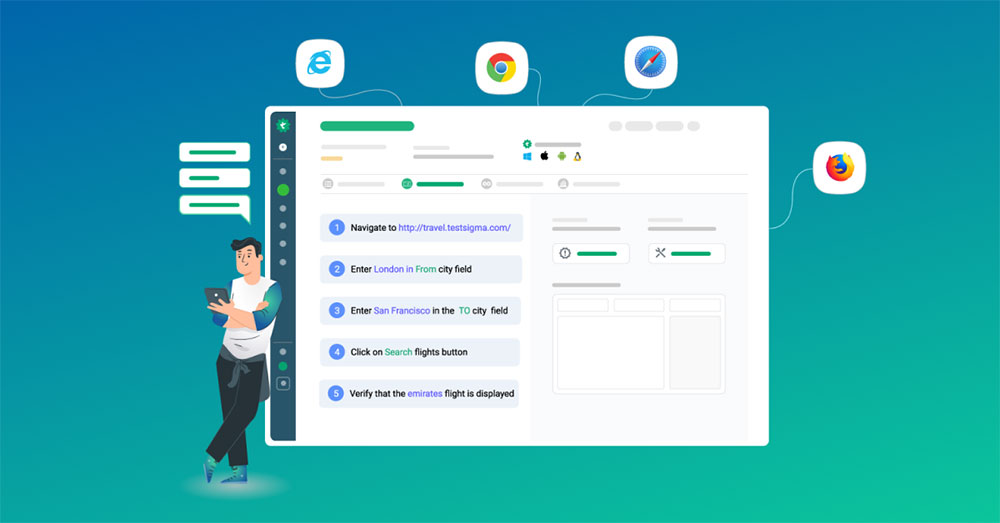No code and open source – why should you try Testsigma

A test automation system and manual testers are two pieces of the testing department that do not go along well. The opposite nature of how manual testers work and what test automation needs to work restricts them from being good friends. However, this does not change that automation has advantages that are hard to ignore, which leaves business owners and managers restricted and morally bound to proceed. What to do when you have manual testers on board but want to change your testing process to automation?
This is not a rare scenario. You are bound to cross this road when you start with a few manual testers and a basic version of an application. In this post, we walk along the same lines to understand the need for automation and the scenarios in which we may want to incline towards it in the future. Later, we may also see some of the most compelling points to consider when you have a manual testing force in your account and conclude this post by giving you some direction in the same regard. The highlights of this post may look like this:
Why do we start with manual testing?
First, what’s the deal with manual testers and automation testing that frequently makes it a point of discussion? The start of a business is always a bumpy road with holes throwing you off at every corner. You have got a budget problem. You have got an infrastructure problem. You are probably just waiting to take this thing to the market somehow till somebody notices you and writes off a cheque.
Such a situation often calls for logical decisions at that point and requires fewer bucks. So, we start with manual testing. Here, testers examine the application manually and give a green or red signal depending on their observation.
Sometimes, only manual testing can only fulfil the need of a business. For example, if you are into the business of OBD devices, you need a manual tester. Later, when the product starts to take shape, you realize a pattern in testing. There is a regular increase in bugs, or it takes a lot longer to clear the product, etc. Then, we think about switching to test automation. Since manual tests have laid a good groundwork, it becomes easy, and we also know that these tests are proven.
Reasons to switch to test automation.
As mentioned in the previous section, there surely be a time when you would think to switch from manual to test automation. The following pointers can help you judge your current stage and the next move ahead.
Delivery cycles are slowing down.
If the delivery cycles are slowing down because testing is taking too much time to complete, it could be a sign that you have too few manual testers or your workload has increased.
Production bugs seem to increase.
When the product starts to become bigger, testing it manually becomes harder. Manual testing is an error-prone method with such large systems. A few bugs will seep into production, and the number will increase over time. When you start to notice this pattern that the number of bugs has begun to increase with time, it shows your manual testing structure is breaking off.
Maintenance costs are increasing.
Manual testing, like any type of testing, requires maintenance over time. The maintenance work is mainly related to rectifying bugs and making new test cases as the number of web elements increases on the page. When we are in a manual setting, the rectification of bugs takes more time than automation.
Manual testing is not an option now.
At a point in time, you might feel that manual testing is not an option for the product at this stage.
For example, data-driven testing requires different data to be input into a single field and test it for its validity. This is where the importance of incorporating a comprehensive test management tool like Jira Test Management comes into play.
Jira Test Management offers a range of features and functionalities that enable efficient test planning, execution, and tracking.
By leveraging Jira Test Management, manual testers can seamlessly transition into the realm of test automation, ensuring effective collaboration and streamlined processes throughout the testing lifecycle.
For example, this is a small sheet depicting a collected data for data-driven testing:

This is a manually repetitive, tiresome, and tedious task. When this happens, the errors increase in testing and take time for rectification. Always keep an eye on the increase in repetitive and manual tasks taken in your company and act accordingly.
Reasons to switch to test automation with manual testers
The above section mentions the scenarios which may help you realize your current situation and determine whether you need to choose automation or not. To do so, we have two options: either hire automation engineers and set up the complete infrastructure again or work with the same set of engineers working up until now.
At this point, as a lot of companies do so, you might feel that the best thing is to start hiring and increase your expense as soon as possible, thinking that the automation engineers can best do the work of automation. However, that may not be the necessary thing to do every time. Even manual testers can help you in your shift towards test automation, and the following points may help you understand why:
You care about your employees.
Moving towards test automation means making a part of the software move to automation previously tested by manual testing. This means fewer testers are required now, and the only solution to save costs is to lay them off.
A layoff is not a good solution until a pandemic like Covid-19 hits you and the revenue have taken a nosedive. Layoffs put an employee in a helpless position affecting three parts of your company at once:
- The employee that has been laid off: Leaving the employee suddenly affects his financials.
- The employees who have not been laid off: Putting pressure on them might force them to look for another job.
- The increase in the unreliability of your brand: Whether it’s the employee you laid off or the one that you did not, all of them will speak negatively for the brand out in public and on social channels.
Keeping each employee in the company and optimizing all your business decisions by keeping them in the center can really help uplift the brand and employee motivation. This definitely helps the business in the long run.
Employees are already familiar with projects.
The testers working on your projects from the start are already familiar with all the testing tasks and project functionalities. You need not spend time making them understand everything from the start as you would with the new testers. This proves helpful in saving time and the costs that will be spent on testing rather than learning.
A sudden increase in costs
For an organization that had all the testing done manually, the initial cost of switching to test automation will be high. Sure, you will get a good return on investment in the long run. But you can only survive the long run if you have money in the initial phase. Apart from the infrastructure costs, an additional element added to it is the automation engineer’s salary. On average, in the United States, an automation engineer’s salary is around $100k annually compared to $64K by manual testers.
Apart from this, also remember that as a tester, the mindset between a manual tester and an automation tester does not differ much. Both have the same skillset and the attitude to approach a test on the same project. It’s just that manual testers do that manually while automation testers write the test script that mimics the same manual action.
How to setup test automation with manual testers
Alright! Now that we understand when to move to test automation and why it is an excellent option to proceed with manual testers, we need to know how to do it.
The conventional test automation methods won’t work here. The first hurdle is learning the programming language and writing scripts with them. Then, we might need to learn an automation framework and a lot of other such automation stuff such as libraries, etc. Teaching a manual tester can be time-consuming, and we waste money with time. It would be better to hire an automation engineer than go this way.
As an alternative, to set up test automation with a manual tester, follow this easy three-step process:
Adopt a no-code platform
A no-code platform is a codeless testing platform. As the name suggests, such a platform avoids scripting test cases with complex logic woven by programming languages. The codeless testing platform adopts approaches such as drag-and-drop, recording the test cases once and running them on various platforms, or sometimes adopting RPA type methods.
Whatever the platform chooses to do, it refrains from asking the tester to write the code. Since this approach is a bit new, fewer good platforms can automate big projects and handle scalability easily. One such tool is Testsigma, and if you are new to codeless testing, it would be an excellent tool to start with.
How can Testisigma help manual testers?
Testsigma is a scriptless testing platform that helps achieve test automation without putting any burden on your local resources. It achieves that by providing a cloud-based infrastructure setup that uses the English language as a medium of communication between itself and the tester.
While operating on Testsigma, test scripts are written in English. So it does not matter if the tester is an automation tester or manual tester, or even a tester to write the scripts. The scripts use natural language processing and help in easy execution with real devices. To start testing on Testsigma, make a free account and proceed towards creating a sample case as follows:

Or you can also convert your actions to test cases with Testsigma’s inbuilt recorder:

Choose the real device on you which you wish to run the tests:

Then analyze your test with a detailed in-built analytics report generated by the tool:

A similar process can be followed for data-driven testing, API testing, or any other type of testing that Testsigma offers.
Do not burden your testers.
No-code test automation tools such as Testsigma provide a platform where test scripts are not required. But still, manual testers need a bit of time to adjust to this new way of testing. Surely they will be able to cope faster but not so quick that they wrap everything tomorrow. While making a switch to test automation with manual testers, it is better to make this switch slowly and give automation tasks to the tester in chunks. You can start with 10% of testing with automation while 90% done as usual. Then increase it by 30% and so on.
Try to use online methods.
A majority of no-code tools are distributed as online software. The reason behind it is their algorithms are constantly improving every day, as this whole concept is a bit new. It is not similar to a test automation framework like Selenium which releases its next version in 4 years. You just download, add the jars, and start writing scripts with such tools.
Online tools are always optimizing for better performance. Their infrastructure can adjust to the scalability of your application. However, in the on-premise setting, you have to keep adjusting the infrastructure according to the project size regularly, which is a bit harder to manage manually. In addition, you also get to save your system resources and operate from anywhere. You just need the login credentials, and all your work is available from any location and any system. Online methods do help in the long run.
Conclusion
Manual testing is not going anywhere. But we also need automation testing to complete our tasks quickly and error-free. The only problem is that automation testing is expensive to perform, and the requirement of the knowledge of programming language restricts the domain of people that can work in it. A company working with manual testers from the start and thinking of switching to automation testing has to make a hard choice. Stuck between the cost of operations and maintenance and the manual tester’s job, they need a solution to establish automation testing with the testers they have in their pool.
A codeless testing platform is a best-suited option when such a scenario arises. The platform does not need any scripting knowledge, and the testers can work with the people who already know every small thing about the project and have dedicated time to the company. Testsigma is a platform that can accept the English language as a method of scripting and convert it into actions. The tool can also convert the testers’ interactive actions to test cases. We would like to ask you your own stories in such situations of switching test automation with manual testers. Let us know in the comment section. Thank you for giving this post your time.
- The Sega Logo History, Colors, Font, And Meaning - 19 April 2024
- Light Up Your Designs with These Light Color Palettes - 19 April 2024
- How to Measure Brand Loyalty Effectively - 19 April 2024









